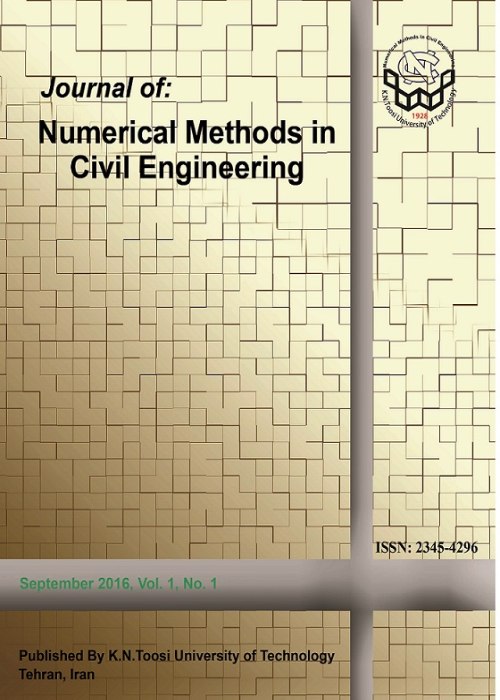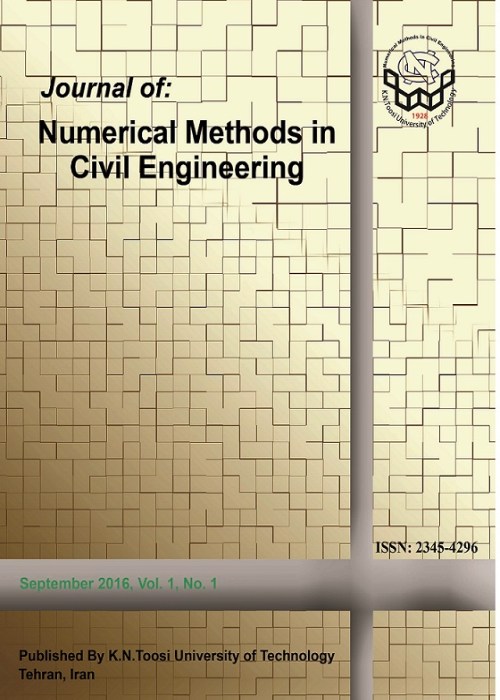فهرست مطالب

Journal of Numerical Methods in Civil Engineering
Volume:8 Issue: 1, Sep 2023
- تاریخ انتشار: 1402/06/10
- تعداد عناوین: 8
-
-
Pages 1-17This study aims to consider the sloshing height and hydrodynamic pressure in roofless and roofed liquid storage tanks utilizing a coupled FE-SPH technique. As a design technique for determining the necessary analyses and main parameters to reach reasonable results, the Taguchi method is used. The SPH formulation models the liquid concerning the large amplitude sloshing waves, and the finite element method simulates the structure. At first, it is found that expressions presented in ACI 350.3-06 should be revised when calculating the sloshing height in a rectangular tank. Secondly, when determining the hydrodynamic pressure applied on the roof and, also the sloshing height, the frequency content of the input ground motion affects significantly the contained liquid responses. Comparison of the results obtained for roofed and roofless tanks indicate no clear correlation between their dynamic responses. The results of this study suggest the ratio of liquid height to its length, the length itself, and earthquake record PGA as noise parameters in Taguchi analysis. At last, the suggested Taguchi analysis’s main design parameters for future studies are the acceleration spectrum intensity ASI and the liquid’s height in the storage tank.Keywords: FE-SPH coupling, Hydrodynamic pressure, Roofed tanks, Sloshing, Taguchi method
-
Pages 18-26It is possible to resolve numerical issues by utilizing a method known as the conventional scaled boundary finite element method (also known as SBFEM), which is a dimension reduction technique. This method can be utilized in conjunction with mesh-free technologies to enhance the numerical characteristics of the conventional SBFEM. Within the scope of this investigation, a novel interpretation of the SBM is presented that makes use of the advantages offered by the meshless local Petrov Galerkin method. Using the moving Kriging interpolation (MKI) method, one can create shape functions that conform to the requirements of the Kronecker delta function property. The interpolating scaled boundary local Petrov Galerkin method that was proposed then can implement essential boundary conditions (ISBLPGM) directly. This new method offers a number of benefits in comparison to scaled boundary approaches that have been presented in the past. It is optional to have a mesh that has been predefined, and the boundary conditions can be determined with very little additional effort. It has been demonstrated that the numerical approach that is being presented yields results that are in very good agreement with analytical and other numerical approaches. Solving the benchmark numerical problems allows for an evaluation of the effectiveness of the proposed method as well as its precisionKeywords: Scaled boundary method, Petrov Galerkin, Mesh-free, Elastostatics, Numerical method
-
Pages 27-34Around the world, many unreinforced masonry buildings have been constructed for different usages, such as schools. Studies have shown the seismic vulnerability of these buildings. Thus nonlinear analysis and seismic assessment of these buildings and improving the retrofitting methods are necessary. One of the retrofitting methods in these buildings is the use of shear walls. In most seismic rehabilitation projects of masonry buildings, piles are used in the foundations of shear walls, and the major retrofit project costs are the foundations and piles. In order to improve the accuracy of the seismic assessment of these buildings, this study investigates the effect of soil and structure interaction on the seismic behavior of these buildings. To reduce the cost of retrofitting shallow strip foundation for new shear walls were added including the effect of rocking, sliding, and settlement responses. It was shown that the interaction of soil and structure in the seismic behavior of masonry buildings retrofitted by squat concrete shear walls reduces the base shear and increases the maximum drift of the building. If this increase in the lateral drift of the building can be tolerated, it will reduce considerably the cost of retrofitting unreinforced masonry buildings.Keywords: Seismic Performance, unreinforced masonry building, squat shear wall, Soil-structure interaction, Nonlinear dynamic analysis
-
Pages 35-44In this article, the enhancement of the seismic function in tall buildings with semi-rigid connections accompanied by the Chevron bracing system was studied. Therefore, it is better to improve the seismic performance of such frames to prevent possible damages and failures. For this purpose, modeling Chevron bracing system was first done using Opensees software by adding zipper columns in tall semi-rigid steel frames in two 12-story and 15-story structures as representatives of tall buildings. 56 semi-rigid frames were analyzed under seven near-fault records using dynamic non-linear time history analysis. The analysis of modeled frames was done for both pinned and ductile connections and the case of removing and adding the zipper column. The results showed that the use of zipper columns in Chevron braces in the steel frames with pinned and semi-rigid connections controls both relative story displacement and maximum lateral story displacement, and this effect is more significant in frames with ductile connections. In other words, more ductility capacity and better dissipation of seismic forces in the near-fault areas for semi-rigid frames could lead to desirable seismic performance. The presence of zipper columns in Chevron braces has made an integrated frame performance in the entire height of the structure due to the transmission of unbalanced vertical forces induced in the braced spans while decreasing story displacements. In addition, it has improved the seismic behavior of semi-rigid steel frames.Keywords: Semi-frames, Chevron braces, Zipper Columns, Near-fault areas, Tall Buildings
-
Pages 45-57This paper uses a parametric numerical study to assess the Lateral-torsional buckling (LTB) performance of several semi-compact beams: S1, S2, and S3. The carrying capacity of these beams, predominantly loaded in bending, is approached by elastic and inelastic buckling analyses. A series of parameters that are believed to influence the resistance to LTB of class 3 beams to (EC3) steel I-beams, namely boundary conditions, flange thickness, and load application level, are investigated. An eigenvalue analysis that predicts the theoretical buckling strength through 3D computational elastic beam models is first conducted using LTBEAM software and ABAQUS. A good agreement in the prediction of Mcr was found. Then, a parametric inelastic buckling analysis is performed using the Riks method implanted in ABAQUS. Results have shown the importance of the lateral restraint conditions and the transverse stiffeners to LTB resistance of compressive flange slenderness following EC3-1-1 for cross sections with a class 3 web and class 1 or 2 flange. In addition, an interaction of local buckling (LB) and LTB in the flanges was observed exclusively for restrained beams. The applied load level strongly affects the beams' elastic and inelastic resistance to LTB.Keywords: Lateral torsional buckling LTB, Local Buckling LB, elastic, inelastic buckling analysis, I-beams, finite element method (FEM) modeling, elastic critical moment Mcr
-
Numerical Analysis of Seepage in Steady and Transient Flow State by the Radial Basis Function MethodPages 58-68Here, the meshless method with the finite difference method has been used to discretize the governing equations of the seepage phenomenon from under the dam in the steady and transient flow. The seepage problem was solved by considering the 6656 triangular mesh and 3449 nodes by the Finite Element Method and was used for validation. The radial basis function method (RBF) was considered one of the methodological methods to solve the seepage problem by considering several points. The results showed that by increasing the number of points, the accuracy of the solution increases, and the error decreases. The results of statistical indicators in the RBF method are reduced compared to the Finite Element Method. The results showed the proximity of the initial approximations to the original answer. The shape factor of the base function depends on the geometry and the governing equation, so the exact shape factor was used for the steady and transient state. In the transient condition, with the water level behind the dam remaining constant, the water head below the dam also reaches a constant value over time. The calculation of statistical indicators showed that the solution by the RBF method has acceptable accuracy.Keywords: Meshless Method, Finite element method, Steady flow, Transient Flow, Seepage
-
Pages 69-78
This research project is aimed at developing the theoretical knowledge of hydraulic-electric coupled flows and its results can be used to zero the flow in a porous medium such as seepage in engineering barriers made with clay and And also the definition of a new concept called electrokinetic engineering barrier. Also, the simulation of the electrokinetic barrier process was carried out using the finite difference method, and the methods of solving the numerical model of this process were investigated. Finally, the Forward Difference Approximation method was proposed due to more accuracy for coding in the MATLAB software. Laboratory studies was provided by an innovative physical model. To achieve this, several experiments were performed on kaolinite soil with a specific gravity of 1.3 gr/cm3, 1.315 gr/cm3, and 1.33 gr/cm3 under different electric potentials and the results of the experiments. They were compared with each other. The results showed that ability of the electrical gradient to generate electro-osmotic flow to overcome the hydraulic flow and create an electrokinetic barrier is affected by the input voltage as well as the dry specific gravity of the samples in the cell and with increasing them, this ability increases so that in the denser sample the electrical gradients applied to the cell were able to stop the hydraulic flow in the higher hydraulic heads while in the less compacted samples the hydraulic heads were stopped at lower values.
Keywords: Electrokinetic Barrier, Kaolinite soil, Coupled flow, Electroosmosis, leakage control -
Pages 79-101
This research investigates the efficiency of Chisala’s model in predicting the moment-rotation curve for double web angle and welded flange plate connections. As many types of connections of steel structures exhibit a semi-rigid (neither totally hinge, nor completely rigid) flexural performance, the determination of their moment-rotation curve is of vital importance since it provides a better vision for structural engineers. In this regard, analytical models of the types of connections mentioned in the title, with components of varying dimensions were created to derive the values of necessary parameters of Chisala’s model. Using the obtained values, the moment-rotation curve for each type of connection was presented. As a means of verification, finite element analysis using Abaqus software was also carried out on each corresponding analytical model. A statistically derived relation, in terms of the parameters of Chisala’s model, was then obtained, utilizing linear regression analysis, and was used afterward, to illustrate the moment-rotation curve for each type of connection. The comparison of moment rotation curves obtained both from analytical models and finite element analysis (FEA) suggest that Chisala’s model is quite efficient and precise when used to illustrate the moment-rotation curve for double web angle and welded flange plate connections, and it can predict moment or rotation values, should the necessary parameters be obtained using a well-defined equivalent analytical model.
Keywords: Chisala’ s model, Moment-rotation curve, double web angle, welded flange plate, finite element analysis


